
My Compressor is Rapid Cycling. Now what?
January 22, 2025
How Variable-Frequency-Drive Air Compressors Work
February 5, 2025Four (and a Half) Critical Compressed Air Safety Tips
Kaishan USA | January 29, 2025| Uncategorized

We recommend doing a safety walk-around before starting your air compressor.
Air compressors are comparatively safe. Safer, in fact, than most other sources of power. Compressed air is the preferred alternative in many applications, especially where flammable or explosive materials are present.
However, it is stored energy, and it needs to be treated with an appropriate level of caution and respect. It needs lock-out/tag-out isolation. It should be stored properly. Tools and hoses should always be inspected for wear. It’s not an exaggeration to say that you may save lives, including your own, by taking them to heart and applying them.
So, it’s always a good idea to take a step back and remind compressed air operators of four high-level tips they should always keep in mind as they perform their daily tasks using compressed air. We also include an extra half-tip at the end for good measure.
These tips apply to any brand and any type, including centrifugal, reciprocating or rotary screw air compressors.
A few seem obvious—in fact, most may be—but the record clearly shows that they have been ignored countless times, with deadly consequences. How many workers were injured when machine safety guards were removed? And how many injuries have happened when hazard stickers were ignored?
We’ll start with electricity.
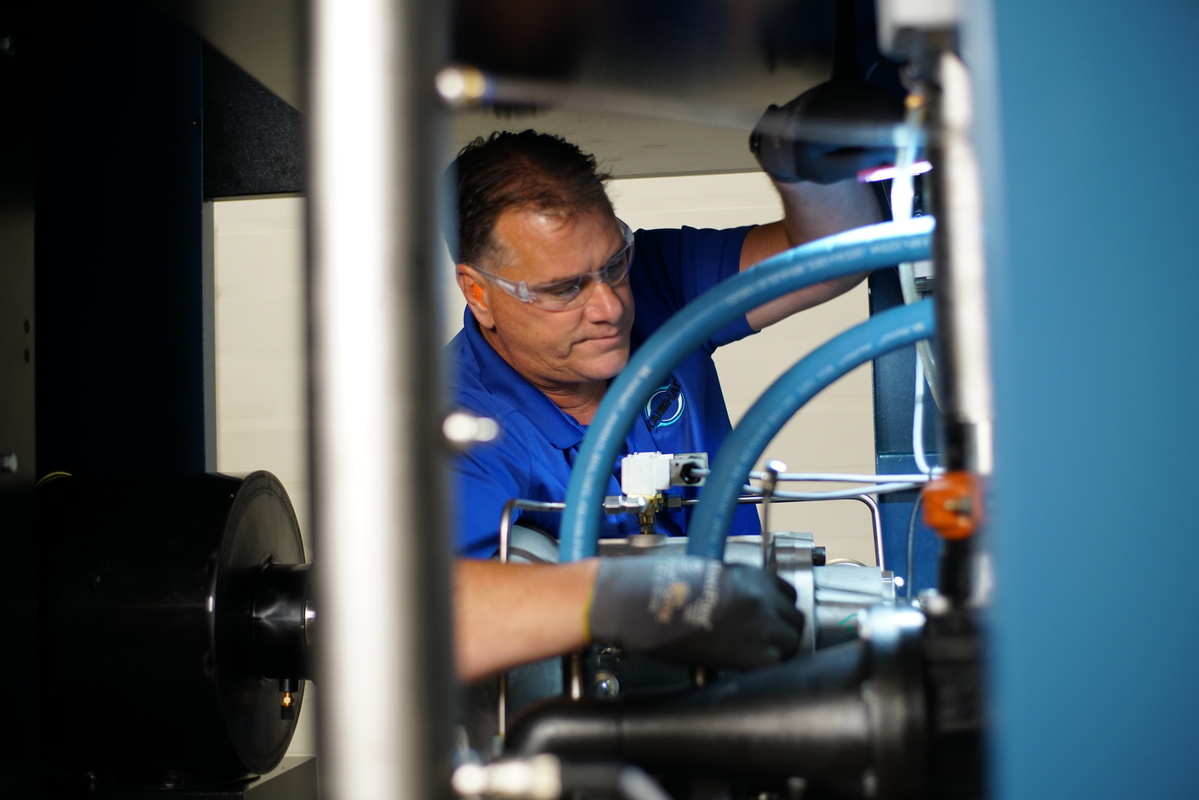
Only a qualified electrician or compressor repair expert should open the control panel.
Tip No. 1. Take Electrical Hazards Seriously
According to the U.S. Occupational Health and Safety Administration (OSHA), 106 people were electrocuted on the job in the U.S. during the year ending July 31, 2024. So, electrical hazards should be taken seriously and they are the most serious but least understood air compressor safety issue.
A typical compressor can have as many as five different voltages inside the control panel. That’s why we say only a qualified person—an electrician or compressor repair person—should open the control panel.
Safety is Built-In
Every Kaishan compressor displays all relevant safety data on the screen of your compressor controls: pressure, temperature, voltage and any amps that are present.
So there’s no need to “pop the hood” like Grandpa did with his ’57 Chevy. More proof that we do everything we can to help you operate our equipment safely. We think we owe that to you.

To make the process easier and safer, Kaishan units display all relevant data on the screen of your compressor controls: pressure, temperature, voltage and any amps that are present.
Before attempting any repair on your compressor, you should make sure you have isolated the machine from its power source. And that includes any stored energy.
A prime example is a variable-speed drive (VSD), which uses an inverter to control the speed of the motor. The VSD stores the energy in a capacitor and releases it as needed. So, you may de-energize the unit, but it may take 10 to 15 minutes or longer to bleed off that energy. Always used your multimeter to ensure there is no power present.
Another potential hazard is rotation.
Tip No. 2. Beware of Moving and Rotating Parts
To get all that work done, your compressor has to rotate or move in some way. If it’s making air, it has moving parts.
Your compressor has hazards and safety guards in place, but operators often remove those warnings as part of regular operation and maintenance of the equipment.
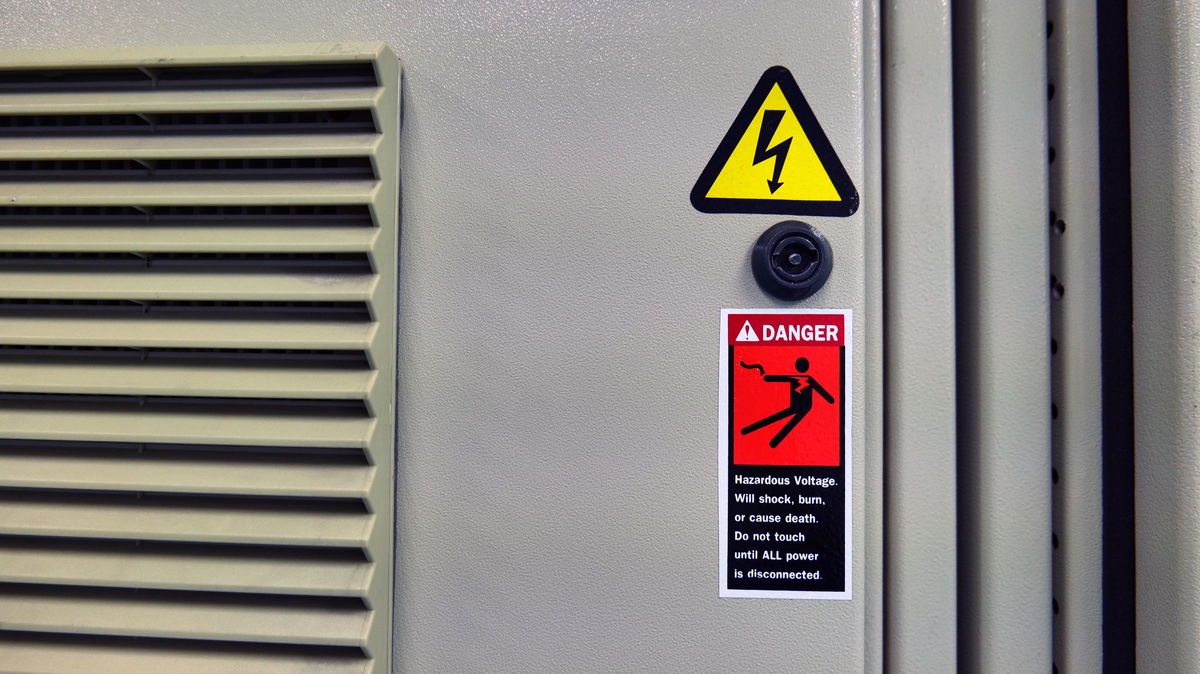
Pay attention to the hazard stickers and safety guards on your machine. And don’t remove them. They're not like the stickers under your living room sofa.
So, before starting your air compressor, you should do a brief walk-around, as you would if you were operating a forklift. Ensure all the safety guards and warnings are still in place, and remind yourself of the potential hazards any piece of rotating equipment presents. Consult your manufacturer’s manual if you have any questions.
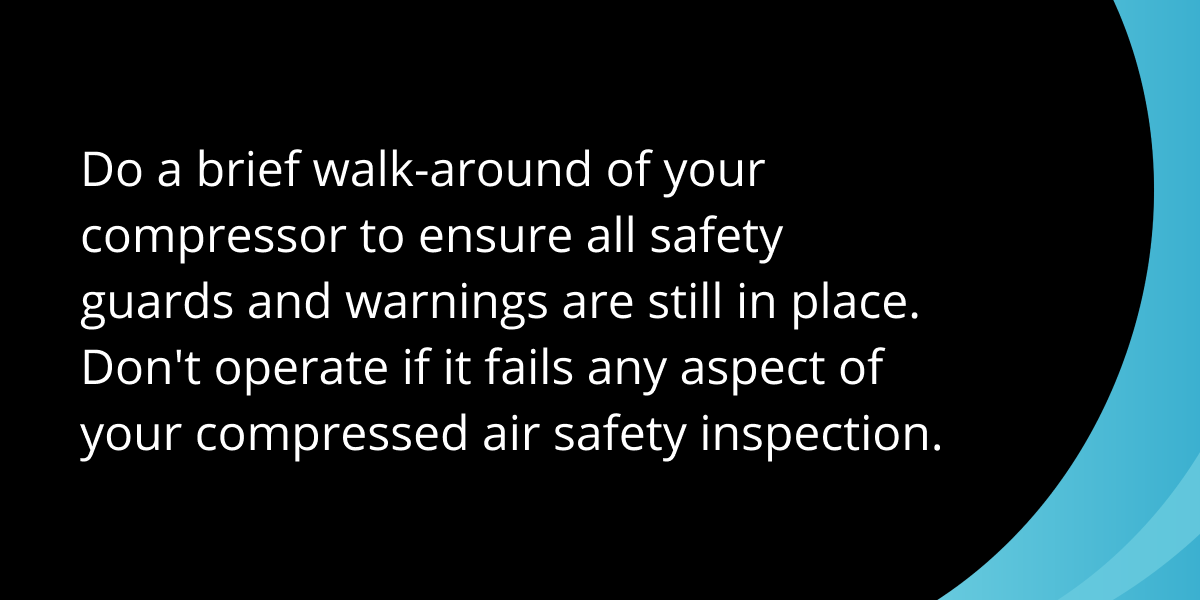
Another serious cause of injury is heat.
Tip No. 3. Remember That Every Metal Component Can Be Hot
Heat is probably the top cause of injuries with compressed air. Depending on the system, you could have temperatures as high as 400° to 500°F.
Burns can happen even with a machine that’s not operating. A compressor can still be hot and take an hour or longer to cool off after it’s been shut down. Every metal component can be hot.
Winter months add additional complications. If external components such as pipes or tools are exposed to low outside temperatures, moisture in the compressed air can freeze. Simply opening a valve can release that pressurized air, which can be loaded with ice crystals that feel like shrapnel when propelled by high-pressure air.
It’s all because of the stored energy in that air. That’s our next topic.
Top No. 4. Don’t Forget That Compressed Air Is Stored Energy Waiting To Be Released
We all too often forget that compressed air itself is stored energy. There’s tremendous pressure just waiting to be released behind every valve, pipe or fitting.
All those devices channel energy into practical work. However, that energy can be released in the wrong place and at the wrong time when people carelessly open a fitting or attempt to bypass a flow control valve, for instance, with unfortunate consequences.
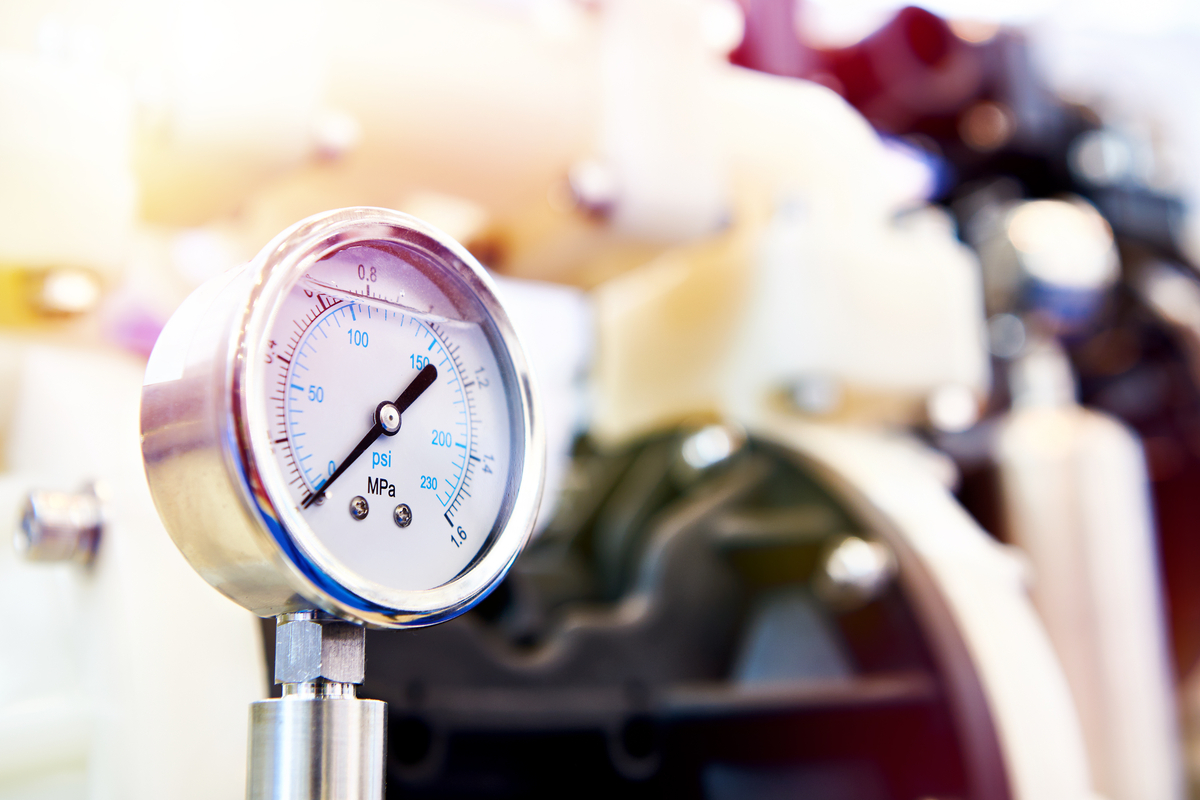
Kaishan includes an internal pressure gauge on every compressor we sell so that you can determine at a glance whether there is pressure inside the machine.
Kaishan is one of the few compressor manufacturers to include an internal pressure gauge on the top of the sump tank on every compressor we sell. So that you can determine at a glance if there is pressure inside the machine. Not just on the control screen but also at the point of use.
Anyone who disassembles any of the machine’s components has a pressure gauge right in front of them. It’s another way Kaishan takes every step possible to keep you and your operators safe.
And that leads to our bonus half-point: we can often be our own worst enemies.
Tip No. 4.5 We Have Met the Enemy, and It Is Us!
First, there’s the matter of focus. You may approach a compressor, knowing that it presents electrical issues. You may confidently believe, “I got this.” And, usually, you do.
However, we all get distracted. Get too confident.
So, you carefully avoid the control panel but touch a hot surface. Or you remember to disconnect the power source but forget about the stored energy in the capacitor. Any of those oversights can be dangerous.
Second, while the voltage, motion, rotation or heat you encounter may not be fatal, your natural reaction to that shock or heat could still be deadly.
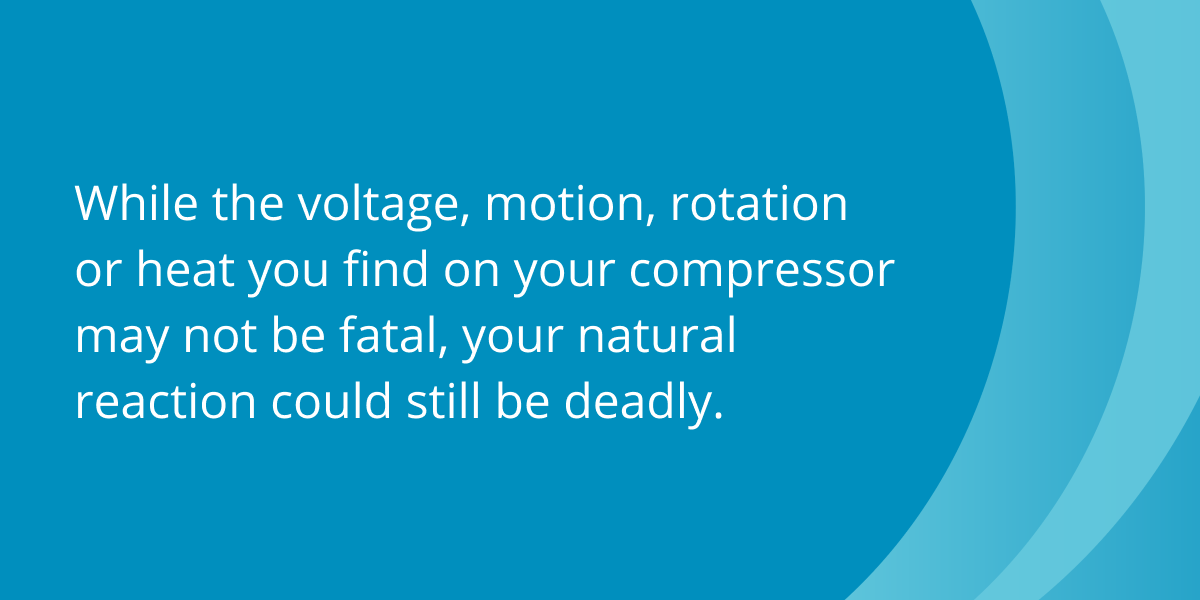
Jumping back or jerking your hand away from a hot or charged surface could cause any number of unplanned or unforeseen consequences. Such as touching a wrench to a live wire. Or jumping into a rotating hazard. The record shows it happens much too often.
Even veteran repair people can forget and get zapped. That doesn’t mean you should be afraid to operate your equipment. However, you should be careful.
Don’t Be Scared, Be Vigilant
The most important takeaway from this post is to be aware. You don’t have to be frightened or scared to operate compressed air equipment that is properly installed and well-maintained, but you should be vigilant.
And that means being alert. Checking the temperature of all surfaces first with a temperature gauge. Looking at the internal pressure gauge before you open an oil cap, a valve or a drain. And keeping the control cabinet closed unless you are a qualified electrician or repair person.
If you need help setting up an air compressor safety program and training all your operators in safe compressor operation, check with your local compressed air professional.
Local Help in Ensuring Safe Air Compressor Operations
Kaishan USA works with a nationwide network of independent distributors, who can provide on-site help and consultation as needed. These factory-trained air compression experts can help you develop a compressed air safety program and train your operators and staff to keep them safe.
Key Takeaways
- A compressor can have as many as five different voltages inside the control panel.
- Only a qualified person—an electrician or compressor repair person—should open a control panel.
- If your compressor is making air, parts of it are moving.
- Even if it’s not working, a compressor can still be hot and take an hour or longer to cool off after it shuts down.
- Every metal component can be hot.
- Kaishan is one of the few compressor manufacturers to include an internal pressure gauge on every compressor we sell.
- Because of distractions and overconfidence, we can sometimes be our own worst enemies.
Let Us Help
Operating your air compressor safely is critical to your operation and the well-being of your employees. If you need help creating an air compressor safety program for your facility, get in touch with the experts at Kaishan. Contact us today.
Listen to the Podcast Version
Understanding the Risks in Compressor Operation
What's up, guys, welcome back to the show.Alright, so, we’re diving right into a fairly big topic today, the top risks you face while operating compressors. And—look, the first one’s a big deal—electrical safety. It’s not just about flipping a switch and hoping for the best.
Yeah, one statistic really stood out to me—106 electrocutions at work in 2024. That’s according to OSHA. I mean, that’s a lot of lives lost.
Exactly. And these aren’t amateur setups we’re talking about. A typical compressor can have up to five different voltages in its control panel. Five, Lisa. That’s not something you mess around with.
Right. And unless you’re a trained electrician or repair tech, you don’t even touch that panel, period. These things aren’t forgiving.
Nope, they’re not. And here’s the safeguard—most modern compressors now display critical safety data on a screen. You’ve got pressure, temperature, voltage, and amps right there. That means no popping the panel open like it’s some DIY project.
And even when the power’s off, there’s stored energy in the system. Take the variable-speed drive. It uses capacitors that can hold energy for up to 15 minutes. If you don’t check, you’re, well, playing Russian roulette, basically.
Yep, multimeter’s your best friend there. Now, let’s move on—rotating parts. Anything that makes air has to move, and moving parts come with their own risks.
Like those safety guards, right? They’re there for a reason. But people take them off during maintenance, or worse, just to make their job faster.
And that’s so dangerous. Before you even start the machine, do a walk-around, kinda like you would for a forklift. Check every guard, every sticker. If something’s missing, fix it before you press the button.
And listen, this isn’t some sticker on your kid’s toy. These warnings save lives. You remove a guard or ignore a hazard label, and suddenly, rotating equipment becomes a whole lot more dangerous.
Speaking of danger—let’s talk about heat. People think “heat injuries” and go straight to fire. But with compressors, burns are just as big a problem.
Yeah, and every component can be hot. We’re talking temps hitting upwards of 500 degrees Fahrenheit, Jason. Even after shutdown, it can take over an hour for some parts to cool down.
Right. Touch the wrong piece and you’re branded like cattle. Not to mention in winter, frozen moisture can turn into high-pressure ice crystals. Imagine getting hit with that.
That’s terrifying! So—what’s the takeaway here? Gloves? Infrared temperature gauges? What’s their best defense?
Both of those, yeah. But honestly, it’s vigilance. You gotta respect the equipment. There's no room for shortcuts here.
The Power and Pitfalls of Compressed Air
Like I said before, it all comes down to vigilance and respect for the equipment. Now let’s talk about compressed air itself—because it’s not just air, it’s stored energy. And stored energy, when mishandled, well, it can go from helpful to hazardous in seconds.Right. It’s easy to forget what’s behind that air—pressure. Tons of it. And if someone opens a line or valve without checking first… I mean, it can be disastrous.
Disastrous is the word. Picture this—you’re cracking open a pressure line, thinking it’s fine, and suddenly you’ve got high-pressure air screaming out. If you’re lucky, it’s just noise.
And if you’re not lucky? You’re dealing with injuries—or worse. It really highlights how easily things can go wrong if you’re, let’s say, overconfident or distracted.
Overconfidence kills. Literally. I’ve seen—well, heard—stories about experienced operators thinking, “I got this,” only to misjudge a situation because they weren’t focused.
It’s that false sense of security, like when you’ve been around the equipment so long, you stop seeing the risks. That’s when bad things happen.
Yeah, and distractions don’t help. One wrong move—like jerking back after touching a hot surface—and bam, you’re in the danger zone.
It’s sorta ironic, isn’t it? The more you know, the easier it can be to overlook the basics.
That’s why tools like those internal pressure gauges Kaishan puts on their compressors are a game changer. You can see the pressure—right there, no guesswork.
Super smart. You’ve got the gauge near the sump tank, the control panel—it’s proactive safety. It makes it easier to know exactly what you’re dealing with before anything’s opened or adjusted.
Exactly. It’s about removing the ‘maybe’ from the equation. Safety works best when it starts before there’s an issue—not after.
So true. And keeping that mindset—the vigilance you mentioned earlier—is key, not just having the tools but actually using them consistently.
Implementing Safety Through Training and Awareness
We’ve talked about the tools, the vigilance, and how safety starts before there’s even an issue—but let’s bring it home. When it comes to the team, how do you make these safety practices really stick day-to-day?Training. It all starts there. You can have the best tools, the clearest labels, but if operators don’t know—or don’t care—about safety, it all falls apart. That’s why Kaishan emphasizes safety training so heavily. They’re not just selling compressors; they’re building safer workplaces.
Right, I was looking through their resources, and they offer everything from custom safety programs to on-site consultations. They even work through local distributors to make sure the training fits each operation. It’s smart because, honestly, no two facilities are exactly the same.
Exactly. And it’s about more than just a one-and-done training day. It’s about creating habits, daily rituals like inspection checklists—walking the floor, checking those guards, ensuring the pressure gauges are where they should be.
Yeah, and having standardized procedures for even the smallest tasks. That consistency is what saves lives. But I think there’s another piece here—leadership. How management approaches safety really sets the tone.
Oh, completely. If leaders don’t prioritize safety, why should anyone else? I’ve seen teams where safety takes a backseat for speed or convenience, and let me tell you—cutting corners always catches up. Always.
Totally. And it’s not just about calling people out when they mess up. Leadership has to celebrate the wins—when teams do things right. Make it clear that safety’s not just a box to check, but part of who they are as a company.
That’s how you build a safety culture. One where vigilance is second nature, where people look out for each other because they want to, not because they have to.
Right. And I mean, look, accidents can still happen—we’re all human. But with the right training, the right tools, and leadership driving the message home, you’re giving your team the best possible chance to stay safe.
That’s what it’s all about—being proactive, not reactive. Safety isn’t just a priority; it’s gotta be part of the everyday operation.
Couldn’t agree more. And with that, Jason, I think we’ve covered the essentials. Thanks for another great discussion.
Right back at ya, Lisa. And to everyone listening—stay safe, stay sharp, and we’ll catch you next time on The Big Dog Podcast.
Random stat or
customer quote
textXXtext
text

